Iron Man
I’m sure for some of you that phrase conjures an image of Robert Downey Jr. in a shiny red suit armed with weapons and a snarky remark. For others a riff from Black Sabbath may begin playing in your mind. Yet, this is a nickname given to an individual whose theories are still causing scientists to explore the oceans regarding the presence, origins, and effects of iron to this day.
In the early 1990’s an oceanographer by the name of John Martin began really pushing his theories that certain parts of the oceans lacked enough iron to support the plankton our planet needed to balance its carbon production; a thought as to why the planet was showing evidence of increased temperatures. Thus the “Iron Hypothesis” was born, spurring a slew of studies looking at iron’s role in the oceans, as well as debates regarding the ethics of “global engineering.” Until then, it had been known that iron was present in the world’s oceans, and constantly being deposited by winds and weathering from arid regions, such as the Sahara Desert. However, Martin thought that if the areas of the oceans low in iron concentration were “seeded” with this metal, then the planktonic blooms created by its presence would begin to off-set the amounts of carbon dissolving into the ocean.
For those of you up on your marine bio, you already know the ocean runs a carbon cycle that is imperative to not only the balance of its waters but
to our atmosphere. Carbon is used up by the phytoplankton in the water’s photic zone (the levels in the ocean where enough light exists for photosynthesis to take place) for their process to produce energy. They in turn release oxygen into the water and atmosphere. As those plankton perish or as zooplankton consume them, the carbon used is trapped in their system. As the zooplankton die or expel fecal pellets, the trapped carbon descends to the sea floor, where it remains in the sediments. Other organisms, such as pteropods and nautiluses use carbonate (a combination of carbon and oxygen) to produce their own shells. As they die, the carbon also remains trapped in their shells and falls to the bottom of the ocean. If these factors are not present, or if the carbon load is too much for this system to handle, an imbalance is created.
“Give me half a tanker of iron and I will give you an ice age,” was John Martin’s famous quote he jokingly quipped regarding his theories. Meaning, if he seeded a large enough patch, it would in turn reverse the climate changes of the Earth as a whole, and even cool it down. This theory spawned the nick names of “Iron Man” and “Johnny Ironseed” as well as much coverage in the media. Martin worked to set up the expedition to test his theory in the open ocean instead of in a bottle in his lab, but sadly passed away before they headed out to test his hypothesis in 1993.
Plankton account for an estimated 90% of the oxygen produced for the atmosphere, instead of mainly the rainforests as I was taught in grade school. To add the nutrients, mainly iron, that boost plankton growth into a bloom would increase the amount of carbon processed by these organisms. When they tried out this theory, it did something close to what Martin predicted: increased the surface plankton levels to a bloom 3 times as much as their previous level. However, Martin thought it would be at least 12 times as much. Two years later, the seeding of iron was replicated, but this time they added twice as much. The yield was an immense 30 times as much chlorophyll at the waters’ surface. Though impractical to reverse climate change, they did exceed Martin’s original theory of increased chlorophyll production.
Today, theories are being tested as to possible multiple origins of iron in the ocean’s systems, as well as the impacts of other added nutrients to the ocean. Not only is Dr. Severmann testing for isotopic levels of the iron collected in the sediments and hypoxic waters, but other scientists are looking as well to see if iron is coming into the oceans through hydrothermal vents or other inlets, as opposed to mainly sourced from nutrient rich dusts from the Earth’s deserts.On a side note, this trip has brought back many memories from high school that I thought were long gone. Back a non-descript time ago, my Biology teacher challenged me to apply the “Iron Hypothesis” in a state competition. I can remember my parents’ reaction as I meticulously checked the test tubes harboring multiple combinations of iron and diatoms on my bedroom windowsills. It was then that science came alive for me, testing firsthand for what we were reading about in our textbooks. Now, again, those feelings are front and center. My hope is that fellow educators following this blog are already, or will begin to be, “doing” science. So many excerpts from the texts I teach with are now amazingly vibrant to me. The hands-on, feet-wet approach to science is so imperative for comprehension, no matter the age of your students. It is extra work, but creating experiences that bring your learning objectives to life strike a deeper chord of understanding in your classes that will resonate for years to come. Not to say everyone should go out on a research expedition to be a solid educator, but you would be amazed at the difference taking a class outside for a lesson makes, when the concept in right in their face.
Whichever way you look at it, iron plays a crucial role in balancing our oceans, as well as our atmosphere.
As we are steaming towards our final station for sampling and study at sea, some things have become inescapably clear to me. One of which is if you look at the careers that require immense sacrifice, you find some of the truest forms of passion in life. You don’t go into a life of research because you answered an ad in a paper and the income is off the charts. You do it because you get to follow the questions spurred by answers you have found, and continually work at something you love. The toughest catch is: everyone on board is either a father, mother, son, daughter, sister, brother, wife, or husband…they are trying to maintain a constant balance between the two worlds they love dearly, and it is not an easy place to work within. Yet, without this level of dedication, think of the discoveries, the perspectives that this society would lack. Those pages and paragraphs of information in your textbook are derived from multiple expeditions, aligned with years of preparation, research, and review, just like this one.
Even with quite a few samples lined up for analysis or needing to be labeled, almost the entire ship was out on the aft deck for just a few moments, caught up in the sunset; watching, reflecting, on the incredible view we were privy to…most likely wondering if their loved ones were sharing in such a remarkable sight as well, or wishing they were there to see it with them after almost three weeks away. You cannot dehumanize studies or careers because you cannot personally relate to their focus or fully comprehend their thinking; we are all similar souls who put on our pants each day one leg at a time, even those dubbed “Iron Man.”


 August 17, 2011
August 17, 2011 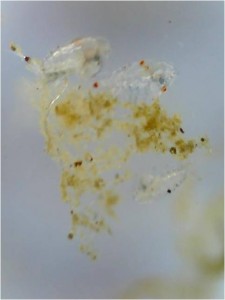
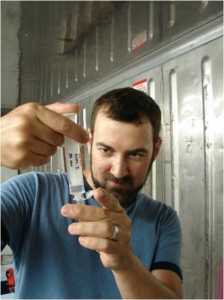
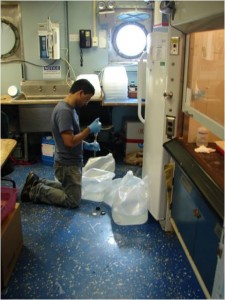
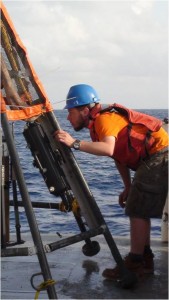

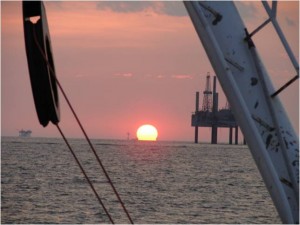







Recent Comments